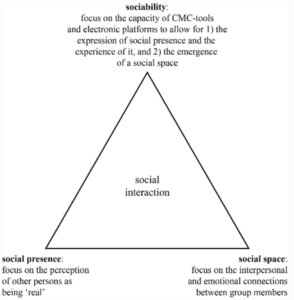Social presence is an important and well-established construct for learning scenarios that make use of online-based technology to mediate learning activities and communication among students. Researchers and practitioners refer to social presence to better understand the socio-emotional dimension of these learning scenarios and/or improve the quality of the experience. However, many researchers in the past have pointed to the shaky foundation that is the conceptualization and measurement of social presence. In other words, there is no agreement on what social presence actually *is* and, consequently, how it should be measured. This makes it difficult to cumulatively build on prior research, possibly explaining the conflicting findings and the rather slow progress this field of research has been making.
Our publication in Educational Psychology Review, authored by Karel Kreijns, Kate Xu, and Joshua Weidlich, attempts to synthesize this area of research by laying out that what is often seen as social presence can actually be distinguished into three related but separate variables: sociability, social space, and social presence.

We trace the origins of these variables and show how they have been defined and measured in the past years and decades. Our goal is to disentangle social presence from its correlates, showing that there are substantive differences making it less-than-ideal to confound them. By highlighting this jingle-fallacy, we hope to lay the groundwork for a more rigorous social presence research that is built on a solid and coherent foundation of empirical findings.
Citation: Kreijns, K., Xu, K., & Weidlich, J. (2021). Social Presence: Conceptualization and Measurement. Educational Psychology Review, doi: https://doi.org/10.1007/s10648-021-09623-8.
